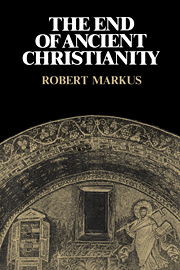Book contents
- Frontmatter
- Contents
- Preface
- Abbreviations
- 1 Introduction: ‘secularity’
- I The crisis of identity
- 2 ‘A great multitude no man could number’
- 3 Conversion and uncertainty
- 4 Augustine: a defence of Christian mediocrity
- 5 ‘Be ye perfect’
- II Kairoi: Christian times and the past
- III Topoi: space and community
- Sources referred to
- Secondary literature referred to
- Index
2 - ‘A great multitude no man could number’
Published online by Cambridge University Press: 05 June 2012
- Frontmatter
- Contents
- Preface
- Abbreviations
- 1 Introduction: ‘secularity’
- I The crisis of identity
- 2 ‘A great multitude no man could number’
- 3 Conversion and uncertainty
- 4 Augustine: a defence of Christian mediocrity
- 5 ‘Be ye perfect’
- II Kairoi: Christian times and the past
- III Topoi: space and community
- Sources referred to
- Secondary literature referred to
- Index
Summary
‘Can any of the faithful doubt that at the hour of the [eucharistic] sacrifice the heavens open at the priest's calling, that in this mystery of Jesus Christ the choirs of angels are present, the heights joined to the depths, earth linked with heaven, the visible united with the invisible?’ In this rhetorical question Gregory the Great summed up the Christians' conviction that their group was part of a vast community. The congregation in the church was an outlying colony, its prayer a faint imitation of the perfect praise unceasingly offered to God by the angels and the saints in heaven. The Church on earth lived in the constant company of a larger community. To that community it was made present in its worship, especially in the celebration of the eucharist. Doubt, variety and development long continued to accompany the Church's attitude towards its dead members: were they to be pitied or envied? Did they need the intercession of the living, or the living theirs? Such doubts took a long time to resolve. Theological reflection and popular piety often found themselves in uneasy relationship where the cult of the dead was concerned. Clerical control was fragile and old custom tenacious. But about the fellowship of the dead and the living in the community of the faithful there was never any doubt.
- Type
- Chapter
- Information
- The End of Ancient Christianity , pp. 21 - 26Publisher: Cambridge University PressPrint publication year: 1991



